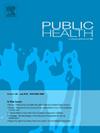A prediction model for virologic failure in adolescents living with HIV in Uganda: Findings from the Suubi+Adherence study
IF 3.9
3区 医学
Q1 PUBLIC, ENVIRONMENTAL & OCCUPATIONAL HEALTH
引用次数: 0
Abstract
Objectives
Adolescents living with HIV (ALHIV) have low viral suppression levels, with 1 in 3 ALHIV experiencing virologic failure, calling for more efforts to reverse these trends. We developed and validated a model that predicts the risk of virologic failure (VF) among ALHIV.
Study design
Cross-sectional study.
Methods
We used baseline data from 702 ALHIV enrolled in the Suubi + Adherence cluster-randomized clinical trial. Participants were aged 10–16 years, living with HIV and aware of their HIV status, and are living with a family. We developed a risk-prediction model for VF (viral load of ≥200 copies/mL) using sociodemographic, behavioral, psychological, economic, and treatment-related factors. LASSO logistic regression using 10-fold cross-validation with bootstrapping was used to select the predictors for the final model. Model performance was assessed by determining the discrimination using the area under the curve and calibration by drawing a calibration plot.
Results
Using a lambda value of 0.007, the final model had 24 predictors (and interaction terms). The predictors included the participants' age, sex, work status, stigma, depressive symptoms, adherence self-efficacy, HIV knowledge, duration with HIV, time spent on ART, communication with the caregiver, family cohesion, social support, orphanhood status, number of people in the household, HIV disclosure, years spent at the current residence, and household asset ownership. The model predicted VF with AUC of 73.8 (95 % CI: 68.3–78.0) and calibration slope of 0.985.
Conclusions
We developed and validated a model to predict the risk of virologic failure among ALHIV in Uganda, demonstrating its potential utility in identifying individuals at elevated risk for VF. Future models could be refined by incorporating clinical characteristics such as CD4 count to further improve predictive accuracy.
乌干达感染艾滋病毒的青少年病毒学失败的预测模型:来自Suubi+依从性研究的发现
青少年艾滋病毒感染者(ALHIV)的病毒抑制水平较低,三分之一的ALHIV经历病毒学失败,呼吁采取更多措施扭转这一趋势。我们开发并验证了一个预测ALHIV病毒病毒学失败(VF)风险的模型。研究设计横断面研究。方法:我们使用702名ALHIV患者的基线数据,这些患者参加了Suubi +依从性集群随机临床试验。参与者年龄在10-16岁之间,感染艾滋病毒并了解自己的艾滋病毒状况,并与家人住在一起。我们利用社会人口学、行为、心理、经济和治疗相关因素建立了VF(病毒载量≥200拷贝/mL)的风险预测模型。LASSO逻辑回归使用10倍交叉验证和自举来选择最终模型的预测因子。通过曲线下面积和绘制校准图来确定识别度,从而评估模型的性能。结果lambda值为0.007,最终模型有24个预测因子(和交互项)。预测因素包括参与者的年龄、性别、工作状态、耻辱、抑郁症状、依从性自我效能、艾滋病毒知识、艾滋病毒感染持续时间、抗逆转录病毒治疗时间、与照顾者的沟通、家庭凝聚力、社会支持、孤儿状况、家庭人数、艾滋病毒披露、在当前住所居住的年限和家庭资产所有权。该模型预测VF的AUC为73.8 (95% CI为68.3 ~ 78.0),校正斜率为0.985。我们开发并验证了一个预测乌干达ALHIV病毒病毒学失败风险的模型,证明了它在识别VF高风险个体方面的潜在效用。未来的模型可以通过纳入临床特征(如CD4计数)来进一步提高预测的准确性。
本文章由计算机程序翻译,如有差异,请以英文原文为准。
求助全文
约1分钟内获得全文
求助全文
来源期刊

Public Health
医学-公共卫生、环境卫生与职业卫生
CiteScore
7.60
自引率
0.00%
发文量
280
审稿时长
37 days
期刊介绍:
Public Health is an international, multidisciplinary peer-reviewed journal. It publishes original papers, reviews and short reports on all aspects of the science, philosophy, and practice of public health.
 求助内容:
求助内容: 应助结果提醒方式:
应助结果提醒方式:


